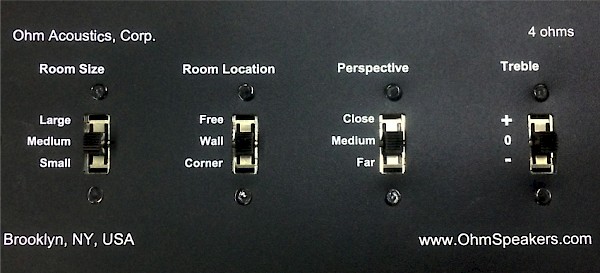Making the Sound Fit the Room
One of the most vexing problems in getting the most out of an audio system is matching it to the acoustics of the room in which it is placed. We talked about this issue in some detail in our post on Room Equalization. That post dealt with the ideas of adjusting the room, treble and bass amplifier controls and external EQ devices.

At Ohm, we’ve taken a further step by allowing the user to modify the output of the speaker so that it better matches the space in which it is located. The switches on the back of the 5000 driver basically function as a four-band equalizer. Moving them up increases the amplitude of the affected frequency area and moving them down decreases the amplitude. However, rather than telling our customers to look at them like they would an equalizer, we gave them the titles – Room Size, Room Position, Perspective and Treble – to help the listener to get the most benefit out of them. Of course, every room is different, so, even once the switches are set in the position that would seem to be correct for your set up, it is still important to experiment until you achieve the balance that sounds the best. Some customers leave all the switches in a straight line and don’t bother adjusting or experimenting with any of them; it is important to note that just because the switches form a straight line doesn’t mean that the frequency response will sound the flattest in your room. This is because some controls have greater ranges than other controls. We try to not make them have any positions that sound bad.
The Room Size
The Room Size switch (the one on the far left) affects the lowest frequencies your speaker reproduces (up to about 80 Hz). This switch is the most important reason why the 5000 is our most versatile speaker: it can be adjusted to sound good in any size room. The walls, floor and ceiling act as acoustic mirrors and each can double the energy in your room at the lowest frequencies. This effect is known as wall-coupling. If the walls are very close together, the effect can be overwhelming (just as car stereos can often have too much bass since a car is a very small room). On the other hand, if the walls are very far apart, the music may sound a little thin. Set this to the size of your room (you can use the room sizes on the chart for our Walsh Tall product line to give you an idea of what we think is “small” or “large”) and adjust to taste from there.
The Room Position
The Room Position switch affects the mid-bass. (~60-150 Hz) Here, too, wall-coupling impacts the performance of your speakers. In this case, the distance of the speaker from the wall changes the highest frequency where this coupling starts to take effect. This switch is designed to eliminate heaviness from this effect when it gets into the lower vocal range. This offers the listener more speaker placement possibilities. Of course, the distance from the wall will still influence the imaging, particularly the apparent sonic height. The wall behind the speakers needs to be acoustically reflective or dispersive, and the switch isn’t a substitute for that. It is also crucial to have a clear line of sight between the two driver assemblies. Moving the switch down is a little like moving the speaker away from the wall: it will reduce high bass “boominess”.
The Perspective
The Perspective switch operates mainly in the vocal range (From 130 to 3000 Hz). This is particularly noticeable with female voices. Put on some music with a female singer and sparse accompaniment. When listening from the sweet-sweep, turn the switch up, and she will appear to move forward. Turn the switch down, and she will move back toward the wall. This switch should be adjusted to taste.
The Treble
Finally, the Treble, (operating in the range above 3000Hz). It affects only the overtones on most things. The result is a little more or less “airiness”. Also, older listeners, like me, and especially males, have hearing that is probably less sensitive in these frequencies. Turning this switch up can help. By way of contrast, young girls often have very sensitive hearing in this range. For them, or just for listening to very bright sounding recordings (perhaps with lots of crash cymbals, or an old record with a lot of hissing and popping), turning this switch down may make the music seem less strident, and more enjoyable. This switch is also useful in adjusting balance for the impact that your room’s decor has on the sound. High carpet, heavy drapes, books, and overstuffed furniture tend to absorb a lot of sound in the treble and make voices sound muted. Turn the switch up to compensate. Similarly, if the room has cement floors, bare drywall, hard chairs, and no curtains on the windows, the voices may be a bit harsh need some attenuation. Turn this switch down.
Neither rooms nor speakers are created equal. Don’t be afraid to play with speaker placement and tone adjustment. If the speakers do not have the kind of sophisticated controls of our Ohm Walsh 5000, the controls on the amp can be adjusted. Getting the “proper” sound for a particular room is sometimes more of an art than a science.
See ya again February 2. Until then,
Enjoy & Good Listening!
John
Subscribe to Ohm News & Views to get the latest posts in your inbox
John Strohbeen Author
John Strohbeen was the President and Chief Engineer of Ohm Acoustics from 1978-2023.


